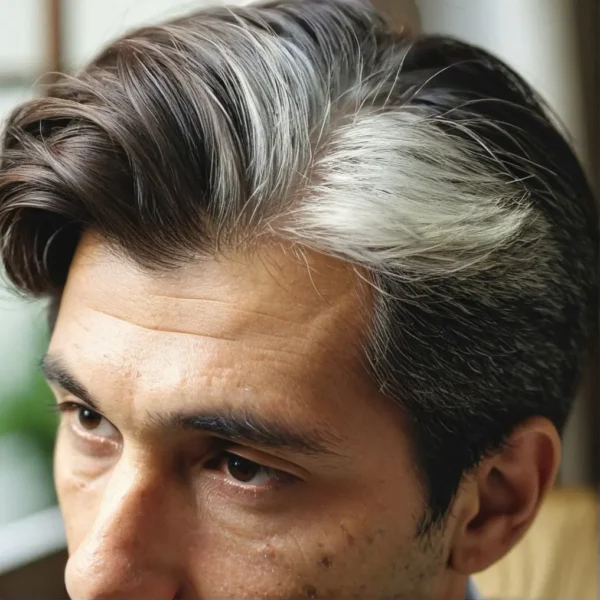Few biological changes announce themselves as clearly – or as emotionally – as the first silver strands of hair on the temples. How quickly those strands multiply affects self‑image, salon schedules, and even product development. Yet the popular “50‑50‑50” rule – that 50 % of people have at least 50 % grey hair at age 50 – is based on data collected from a small Australian cohort six decades ago and has never been rigorously confirmed. A much larger 2012 multinational survey of 4,192 adults showed that the rule is more myth than fact, and fresh mechanistic studies are rewriting what we know about the greying clock in our hair.
A quick primer on hair pigmentation: Every hair bulb contains pigment‑producing melanocytes fed by a reservoir of melanocyte stem cells (McSCs) located in the hair follicle outer root sheath. During the growth (anagen) phase, mature melanocyte cells in the hair bulb hand melanin granules to keratinocytes, colouring the emerging hair fiber. When oxidative stress, genetic programming or stem‑cell exhaustion disrupt that assembly line, the shaft emerges first “faded” (grey) and eventually devoid of pigment (white). Two recent breakthroughs sharpen the picture:
Stem‑cell “traffic jams”. In 2023 researchers showed that with age, McSCs can become physically “stuck” in the root sheath compartment of the follicle where they can no longer receive signals to mature, leading to permanent colour loss. Restoring their mobility in mice partially reversed greying, suggesting that the process may not be strictly one‑way.Genetic tempo setters. Genome‑wide association work confirms that variants in genes IRF4 , BCL2 and MC1R modulate the pace of pigment loss, and that heritability explains roughly 30–40 % of grey hair onset timing variability in different people. When does greying start: Large epidemiological series converge on three broad timelines. Across the major ancestral groups studied, first grey strands usually appear sometime in early to middle adulthood, but the average age differs markedly by phototype:
People of European ancestry typically notice their earliest silver threads in their mid‑thirties – around 34 years on average.Individuals of East or South Asian descent tend to experience first greys a little later, most often between 37 and 39 years of age.Those with African ancestry usually begin greying last, with the first visible strands emerging, on average, nearer to their mid‑forties (about 44 years). Because of these baseline differences, clinicians define “premature” greying relative to each group’s usual timeline: before age 20 in Caucasians, before 25 in Asians, and before 30 in people of African descent. Remember, however, that genetics and lifestyle introduce wide person‑to‑person variation, so these figures represent statistical mid‑points rather than strict biological deadlines.
How fast does greying progress: A study from 2012 examined grey hair assessed in three scalp zones (vertex, temple, occiput ) in 1,464 middle‑aged adults across 23 different regions of the world. Their key findings were:
Incidence: By 45 years, 57 % of participants already had ≥ 5 % grey hair. By 65 years that figure rose to 91 %.Intensity: Mean grey coverage climbed almost linearly from ~15 % at 45 y to ~40 % at 65 y – about 1.2 percentage points each year.Gender: Men showed both higher incidence (78 %) and higher intensity (29 %) than women (71 % / 25 %).Distribution: Temples lead the parade, followed by the vertex; the occiput lags by several years, especially in women. Revising the “50 ‑ 50 ‑ 50 ” rule: At age 50 the proportion of people whose heads are at least half grey ranged from 6 % in Sub‑Saharan Africans to 23 % in Northern Europeans. This is far below 50 % in every group studied. The original rule therefore overestimates both the speed and the universality of greying.
Decade‑by‑decade snapshot: Overall, there is a progression in grey hair development that can be approximately defined by decade of age.
20s: Sporadic strands in genetically predisposed individuals; premature greying often linked to family history, autoimmune disease or severe stress.30s: Visible in one third of Caucasians, but still uncommon in most Asian and Black populations.40s: Rapid inflection point – especially noticeable in men – as cumulative oxidative stress, hormonal shifts and stem‑cell attrition accelerate.50s: Majority have some grey; however, only one in five Europeans and fewer Africans/Asians cross the 50 % coverage mark.60s and beyond: Near‑universal greying, though small islands of pigmented hair often persist, highlighting significant follicle‑to‑follicle variability. 5. Factors that speed (or slow) the clock: Several influences can hasten pigment loss, while a few appear to exert a modest protective effect.
Genetic makeup remains the strongest driver. Family studies and twin research show that the timing and tempo of greying track closely within bloodlines; variations in genes such as IRF4 , BCL2 and MC1R explain roughly one‑third of the observed differences between individuals.Smoking doubles the odds of early greying. The oxidative burden generated by tobacco smoke damages both melanocytes and their stem‑cell reserves, bringing forward the first noticeable greys and accelerating subsequent spread.Nutrient deficits – especially of vitamin B‑12, vitamin D and iron (ferritin) – can push the timeline forward. Clinical case series document repigmentation or a marked slowdown once deficiencies are corrected, suggesting that adequate micronutrient status helps preserve melanocyte function.Psychological stress is another accelerator. Animal models demonstrate that surges of noradrenaline can deplete melanocyte stem cells, and human surveys consistently link high perceived stress with earlier onset and faster progression of greying.Metabolic strain from obesity and insulin resistance also correlates with premature greys. Chronic low‑grade inflammation and elevated reactive oxygen species in these conditions appear to erode the follicle’s pigment‑producing machinery.Cumulative ultraviolet exposure can hasten the process – particularly in lighter hair. UV light inflicts direct oxidative damage on melanocytes and indirectly stresses the follicular micro‑environment, nudging follicles toward a pigment‑free state. Protective associations are much less clear, but diets rich in antioxidant‑dense fruit, vegetables and omega‑3 fatty acids correlate with later onset in small cohorts, pointing towards oxidative stress as a modifiable pathway.
Practical takeaways for hair professionals: There are several conclusions that can be drawn from the research data on hair greying:
Individualise expectations. A client in their mid‑50s with 20 % grey hairis entirely within the bell curve- especially for darker skin/hair phototypes. Avoid framing this grey hair as premature.Map the landscape. Because the temples and frontal hairline grey first, strategic partial highlights or lowlights can camouflage early changes with minimal chemical exposure.Check the basics. Sudden, patchy or very early greying (< 20 y) might warrant medical review for nutritional deficits, thyroid disease, or autoimmune disorders such as vitiligo.Counsel on lifestyle. Smoking cessation, UV protection and stress‑management strategies are evidence‑based recommendations that benefit overall health while potentially slowing hair pigment loss.Colour with care. Grey fibers are often coarser and more porous; they may resist dye uptake or color can fade quickly. Formulations with balanced alkalinity and conditioning agents mitigate these issues.Stay sceptical but curious. Stem‑cell‑targeted serums and oral antioxidants for reducing grey hair are promising but unproven. Monitor peer‑reviewed data rather than any treatment marketing claims. What the future may hold: Targeted activation of dormant McSCs, CRISPR editing of pigment‑pathway genes, and microneedle delivery of antioxidant enzymes are all under active investigation for treating grey hair. While a safe, reliable “anti‑grey hair pill” remains speculative, the research momentum since 2020 suggests that partial, personalised interventions could emerge within the next decade – especially for those in the early stages of greying.
Conclusions: The largest multinational survey to date shows that only 6–23 % of 50‑year‑olds – not 50 % – have hair that is half grey, debunking the long‑standing rule of thumb. On average, people accumulate roughly one additional percentage point of grey coverage per year between their mid‑40s and mid‑60s, with men greying slightly faster than women, and those of European ancestry faster than their Asian or African peers. Lifestyle, nutritional and emerging biological factors modulate this trajectory, offering both challenges and opportunities for professionals and consumers alike.
Understanding the true pace – and the true variability – of pigment loss allows for more realistic expectations, smarter salon strategies, and perhaps, in time, targeted therapies that treat greying not as an inevitable cliff, but as a slope that can be safely reshaped. The Bottom line: Hair greying is a gradual, genetically choreographed process that accelerates with age but unfolds at very different speeds across populations and individuals.
Bibliography
11711645 {11711645:EJ5M4YFP},{11711645:2RSWTDMD},{11711645:6AWLKM54},{11711645:J6EZ7LRZ},{11711645:A74R977W},{11711645:ZCM8QLPZ},{11711645:3MEQRA4M},{11711645:TKVXLTR5},{11711645:7NWVIXYM},{11711645:T9FNGAII},{11711645:Y4JYUC34},{11711645:9MEQSGMS} 1 vancouver 50 date asc 1883 https://www.keratin.com/wp-content/plugins/zotpress/ %7B%22status%22%3A%22success%22%2C%22updateneeded%22%3Afalse%2C%22instance%22%3Afalse%2C%22meta%22%3A%7B%22request_last%22%3A0%2C%22request_next%22%3A0%2C%22used_cache%22%3Atrue%7D%2C%22data%22%3A%5B%7B%22key%22%3A%22EJ5M4YFP%22%2C%22library%22%3A%7B%22id%22%3A11711645%7D%2C%22meta%22%3A%7B%22creatorSummary%22%3A%22Keogh%20and%20Walsh%22%2C%22parsedDate%22%3A%221965-08-21%22%2C%22numChildren%22%3A0%7D%2C%22bib%22%3A%22%26lt%3Bdiv%20class%3D%26quot%3Bcsl-bib-body%26quot%3B%20style%3D%26quot%3Bline-height%3A%201.35%3B%20%26quot%3B%26gt%3B%5Cn%20%20%26lt%3Bdiv%20class%3D%26quot%3Bcsl-entry%26quot%3B%20style%3D%26quot%3Bclear%3A%20left%3B%20%26quot%3B%26gt%3B%5Cn%20%20%20%20%26lt%3Bdiv%20class%3D%26quot%3Bcsl-left-margin%26quot%3B%20style%3D%26quot%3Bfloat%3A%20left%3B%20padding-right%3A%200.5em%3B%20text-align%3A%20right%3B%20width%3A%201em%3B%26quot%3B%26gt%3B1.%26lt%3B%5C%2Fdiv%26gt%3B%26lt%3Bdiv%20class%3D%26quot%3Bcsl-right-inline%26quot%3B%20style%3D%26quot%3Bmargin%3A%200%20.4em%200%201.5em%3B%26quot%3B%26gt%3BKeogh%20EV%2C%20Walsh%20RJ.%20Rate%20of%20greying%20of%20human%20hair.%20Nature.%201965%20Aug%2021%3B207%28999%29%3A877%26%23x2013%3B8.%26lt%3B%5C%2Fdiv%26gt%3B%5Cn%20%20%20%26lt%3B%5C%2Fdiv%26gt%3B%5Cn%26lt%3B%5C%2Fdiv%26gt%3B%22%2C%22data%22%3A%7B%22itemType%22%3A%22journalArticle%22%2C%22title%22%3A%22Rate%20of%20greying%20of%20human%20hair%22%2C%22creators%22%3A%5B%7B%22creatorType%22%3A%22author%22%2C%22firstName%22%3A%22E.%20V.%22%2C%22lastName%22%3A%22Keogh%22%7D%2C%7B%22creatorType%22%3A%22author%22%2C%22firstName%22%3A%22R.%20J.%22%2C%22lastName%22%3A%22Walsh%22%7D%5D%2C%22abstractNote%22%3A%22%22%2C%22date%22%3A%221965-08-21%22%2C%22language%22%3A%22eng%22%2C%22DOI%22%3A%2210.1038%5C%2F207877a0%22%2C%22ISSN%22%3A%220028-0836%22%2C%22url%22%3A%22%22%2C%22collections%22%3A%5B%22BG3PGVGE%22%5D%2C%22dateModified%22%3A%222025-07-17T14%3A31%3A19Z%22%7D%7D%2C%7B%22key%22%3A%222RSWTDMD%22%2C%22library%22%3A%7B%22id%22%3A11711645%7D%2C%22meta%22%3A%7B%22creatorSummary%22%3A%22Cline%22%2C%22parsedDate%22%3A%221988-04%22%2C%22numChildren%22%3A0%7D%2C%22bib%22%3A%22%26lt%3Bdiv%20class%3D%26quot%3Bcsl-bib-body%26quot%3B%20style%3D%26quot%3Bline-height%3A%201.35%3B%20%26quot%3B%26gt%3B%5Cn%20%20%26lt%3Bdiv%20class%3D%26quot%3Bcsl-entry%26quot%3B%20style%3D%26quot%3Bclear%3A%20left%3B%20%26quot%3B%26gt%3B%5Cn%20%20%20%20%26lt%3Bdiv%20class%3D%26quot%3Bcsl-left-margin%26quot%3B%20style%3D%26quot%3Bfloat%3A%20left%3B%20padding-right%3A%200.5em%3B%20text-align%3A%20right%3B%20width%3A%201em%3B%26quot%3B%26gt%3B1.%26lt%3B%5C%2Fdiv%26gt%3B%26lt%3Bdiv%20class%3D%26quot%3Bcsl-right-inline%26quot%3B%20style%3D%26quot%3Bmargin%3A%200%20.4em%200%201.5em%3B%26quot%3B%26gt%3BCline%20DJ.%20Changes%20in%20hair%20color.%20Dermatol%20Clin.%201988%20Apr%3B6%282%29%3A295%26%23x2013%3B303.%26lt%3B%5C%2Fdiv%26gt%3B%5Cn%20%20%20%26lt%3B%5C%2Fdiv%26gt%3B%5Cn%26lt%3B%5C%2Fdiv%26gt%3B%22%2C%22data%22%3A%7B%22itemType%22%3A%22journalArticle%22%2C%22title%22%3A%22Changes%20in%20hair%20color%22%2C%22creators%22%3A%5B%7B%22creatorType%22%3A%22author%22%2C%22firstName%22%3A%22D.%20J.%22%2C%22lastName%22%3A%22Cline%22%7D%5D%2C%22abstractNote%22%3A%22Hair%20color%20changes%20result%20not%20only%20from%20alterations%20of%20melanin%20production%20but%20also%20from%20changes%20in%20the%20hair%20structure%20itself%2C%20altering%20its%20optical%20properties.%20A%20variety%20of%20genetic%2C%20metabolic%2C%20nutritional%2C%20and%20acquired%20disorders%20result%20in%20hair%20color%20changes.%20When%20the%20underlying%20defect%20can%20be%20corrected%2C%20hair%20color%20usually%20returns%20to%20normal.%20The%20flag%20sign%20can%20occur%20as%20a%20result%20of%20nutritional%20insults%20or%20due%20to%20medications.%20Most%20drug-induced%20changes%20in%20hair%20color%20result%20in%20lighter%20hair%20color%2C%20although%20PABA%20and%20some%20chemotherapy%20regimens%20have%20darkened%20hair.%20Green%20hair%20due%20to%20exogenous%20copper%20may%20be%20associated%20with%20prior%20damage%20to%20the%20hair%20cuticle.%20Alopecia%20areata%20may%20selectively%20involve%20pigmented%20hairs.%20Regrowing%20white%20hairs%20have%20shown%20both%20keratinocyte%20and%20melanocyte%20abnormalities.%20Gray%20hair%20may%20temporarily%20darken%20after%20inflammatory%20processes%2C%20after%20electron-beam-induced%20alopecia%2C%20and%20after%20some%20chemotherapy%20regimens.%20Much%20remains%20to%20be%20learned%20about%20the%20physiology%20of%20human%20graying.%22%2C%22date%22%3A%221988-04%22%2C%22language%22%3A%22eng%22%2C%22DOI%22%3A%22%22%2C%22ISSN%22%3A%220733-8635%22%2C%22url%22%3A%22%22%2C%22collections%22%3A%5B%22BG3PGVGE%22%5D%2C%22dateModified%22%3A%222025-07-16T14%3A33%3A23Z%22%7D%7D%2C%7B%22key%22%3A%226AWLKM54%22%2C%22library%22%3A%7B%22id%22%3A11711645%7D%2C%22meta%22%3A%7B%22creatorSummary%22%3A%22Mosley%20and%20Gibbs%22%2C%22parsedDate%22%3A%221996-12-21%22%2C%22numChildren%22%3A0%7D%2C%22bib%22%3A%22%26lt%3Bdiv%20class%3D%26quot%3Bcsl-bib-body%26quot%3B%20style%3D%26quot%3Bline-height%3A%201.35%3B%20%26quot%3B%26gt%3B%5Cn%20%20%26lt%3Bdiv%20class%3D%26quot%3Bcsl-entry%26quot%3B%20style%3D%26quot%3Bclear%3A%20left%3B%20%26quot%3B%26gt%3B%5Cn%20%20%20%20%26lt%3Bdiv%20class%3D%26quot%3Bcsl-left-margin%26quot%3B%20style%3D%26quot%3Bfloat%3A%20left%3B%20padding-right%3A%200.5em%3B%20text-align%3A%20right%3B%20width%3A%201em%3B%26quot%3B%26gt%3B1.%26lt%3B%5C%2Fdiv%26gt%3B%26lt%3Bdiv%20class%3D%26quot%3Bcsl-right-inline%26quot%3B%20style%3D%26quot%3Bmargin%3A%200%20.4em%200%201.5em%3B%26quot%3B%26gt%3BMosley%20JG%2C%20Gibbs%20AC.%20Premature%20grey%20hair%20and%20hair%20loss%20among%20smokers%3A%20a%20new%20opportunity%20for%20health%20education%3F%20BMJ.%201996%20Dec%2021%3B313%287072%29%3A1616.%26lt%3B%5C%2Fdiv%26gt%3B%5Cn%20%20%20%26lt%3B%5C%2Fdiv%26gt%3B%5Cn%26lt%3B%5C%2Fdiv%26gt%3B%22%2C%22data%22%3A%7B%22itemType%22%3A%22journalArticle%22%2C%22title%22%3A%22Premature%20grey%20hair%20and%20hair%20loss%20among%20smokers%3A%20a%20new%20opportunity%20for%20health%20education%3F%22%2C%22creators%22%3A%5B%7B%22creatorType%22%3A%22author%22%2C%22firstName%22%3A%22J.%20G.%22%2C%22lastName%22%3A%22Mosley%22%7D%2C%7B%22creatorType%22%3A%22author%22%2C%22firstName%22%3A%22A.%20C.%22%2C%22lastName%22%3A%22Gibbs%22%7D%5D%2C%22abstractNote%22%3A%22%22%2C%22date%22%3A%221996%20Dec%2021-28%22%2C%22language%22%3A%22eng%22%2C%22DOI%22%3A%2210.1136%5C%2Fbmj.313.7072.1616%22%2C%22ISSN%22%3A%220959-8138%22%2C%22url%22%3A%22%22%2C%22collections%22%3A%5B%22BG3PGVGE%22%5D%2C%22dateModified%22%3A%222025-07-16T14%3A32%3A55Z%22%7D%7D%2C%7B%22key%22%3A%22J6EZ7LRZ%22%2C%22library%22%3A%7B%22id%22%3A11711645%7D%2C%22meta%22%3A%7B%22creatorSummary%22%3A%22Wollina%22%2C%22parsedDate%22%3A%222005-12%22%2C%22numChildren%22%3A0%7D%2C%22bib%22%3A%22%26lt%3Bdiv%20class%3D%26quot%3Bcsl-bib-body%26quot%3B%20style%3D%26quot%3Bline-height%3A%201.35%3B%20%26quot%3B%26gt%3B%5Cn%20%20%26lt%3Bdiv%20class%3D%26quot%3Bcsl-entry%26quot%3B%20style%3D%26quot%3Bclear%3A%20left%3B%20%26quot%3B%26gt%3B%5Cn%20%20%20%20%26lt%3Bdiv%20class%3D%26quot%3Bcsl-left-margin%26quot%3B%20style%3D%26quot%3Bfloat%3A%20left%3B%20padding-right%3A%200.5em%3B%20text-align%3A%20right%3B%20width%3A%201em%3B%26quot%3B%26gt%3B1.%26lt%3B%5C%2Fdiv%26gt%3B%26lt%3Bdiv%20class%3D%26quot%3Bcsl-right-inline%26quot%3B%20style%3D%26quot%3Bmargin%3A%200%20.4em%200%201.5em%3B%26quot%3B%26gt%3BWollina%20U.%20Eyebrow%20colour%20in%20diabetics.%20Acta%20Dermatovenerol%20Alp%20Pannonica%20Adriat.%202005%20Dec%3B14%284%29%3A157%26%23x2013%3B60.%26lt%3B%5C%2Fdiv%26gt%3B%5Cn%20%20%20%26lt%3B%5C%2Fdiv%26gt%3B%5Cn%26lt%3B%5C%2Fdiv%26gt%3B%22%2C%22data%22%3A%7B%22itemType%22%3A%22journalArticle%22%2C%22title%22%3A%22Eyebrow%20colour%20in%20diabetics%22%2C%22creators%22%3A%5B%7B%22creatorType%22%3A%22author%22%2C%22firstName%22%3A%22U.%22%2C%22lastName%22%3A%22Wollina%22%7D%5D%2C%22abstractNote%22%3A%22BACKGROUND%3A%20Hair%20colour%20may%20be%20affected%20by%20a%20metabolic%20disease.%20Systematic%20investigations%20in%20diabetics%20are%20missing.%5CnOBJECTIVE%3A%20A%20clinical%20study%20was%20performed%20to%20evaluate%20whether%20dark%20colour%20of%20eyebrows%20in%20greying%20males%20is%20associated%20with%20diabetes%20or%20not.%5CnSETTING%3A%20Academic%20teaching%20hospital%2C%20inpatient%20and%20outpatient%20department.%5CnMETHODS%3A%20In%20an%20uncontrolled%20analysis%20two%20groups%20of%20male%20patients%20between%2050%20to%2070%20years%20of%20age%20were%20investigated%20for%20evidence%20of%20diabetes%20mellitus.%20Inclusion%20criteria%20were%20original%20scalp%20hair%20colour%20brown%20to%20black%20with%20more%20than%2050%25%20greying%20hair%2C%20no%20chemotherapy%2C%20hormone%20%28except%20insulin%29%20or%20interferon%20treatment%2C%20current%20or%20previous%2C%20no%20artificial%20colouring%20of%20hair%2C%20and%20absence%20of%20total%20alopecia.%20Group%20A%20consisted%20of%2050%20males%20with%20dark%20eyebrow%20colour%2C%20group%20B%20of%2050%20males%20with%20greying%20of%20eyebrows.%20A%20careful%20medical%20history%20and%20clinical%20examination%20was%20performed.%20In%20patients%20without%20known%20diabetes%2C%20blood%20sugar%20levels%20%28profile%20during%20the%20day%29%20and%20HbA1c%20were%20evaluated.%5CnRESULTS%3A%20In%20group%20A%2038%20of%2050%20patients%20%2876%25%29%20were%20diabetics%20type%20II.%20The%20mean%20duration%20of%20diabetes%20was%203.4%20years%20%28SD%206.8%20years%3B%20range%201%20year%20to%2031%20years%29.%20Six%20patients%20were%20diagnosed%20as%20having%20diabetes%20for%20the%20first%20time.%20In%20group%20B%209%20of%2050%20patients%20%2818%25%29%20were%20diabetics%2C%20two%20of%20type%20I%20and%207%20of%20type%20II.%20One%20patient%20with%20a%20newly%20detected%20diabetes%20type%20II%20was%20seen.%20The%20mean%20duration%20of%20diabetes%20was%204.1%20years%20%28SD%207.6%20years%3B%20range%3A%201%20year%20to%2039%20years%29.%20The%20difference%20in%20diabetes%20frequency%20is%20statistically%20highly%20significant%20%28two-sided%20t-test%3A%20p%26lt%3B0.0001%29.%20Odds%20ratios%20%28OR%29%20for%20diabetes%20are%20higher%20in%20greying%20males%20with%20dark%20eyebrows%20%28OR%203.17%29%20vs.%20those%20with%20greying%20eyebrows%20and%20scalp%20hair%20%28OR%200.19%29%20in%20this%20age%20group.%5CnCONCLUSIONS%3A%20In%20male%20diabetics%20at%20the%20age%20of%2050%20years%20or%20more%20greying%20of%20the%20eyebrows%20seems%20to%20be%20inhibited%20or%20delayed.%20The%20presence%20of%20dark%20eyebrows%20with%20greying%20scalp%20hair%20in%20males%20might%20be%20a%20clinical%20sign%20for%20patients%20at%20risk%20of%20diabetes%20type%20II.%22%2C%22date%22%3A%222005-12%22%2C%22language%22%3A%22eng%22%2C%22DOI%22%3A%22%22%2C%22ISSN%22%3A%221318-4458%22%2C%22url%22%3A%22%22%2C%22collections%22%3A%5B%22BG3PGVGE%22%5D%2C%22dateModified%22%3A%222025-07-16T14%3A32%3A41Z%22%7D%7D%2C%7B%22key%22%3A%22A74R977W%22%2C%22library%22%3A%7B%22id%22%3A11711645%7D%2C%22meta%22%3A%7B%22creatorSummary%22%3A%22Tr%5Cu00fceb%22%2C%22parsedDate%22%3A%222009-01%22%2C%22numChildren%22%3A0%7D%2C%22bib%22%3A%22%26lt%3Bdiv%20class%3D%26quot%3Bcsl-bib-body%26quot%3B%20style%3D%26quot%3Bline-height%3A%201.35%3B%20%26quot%3B%26gt%3B%5Cn%20%20%26lt%3Bdiv%20class%3D%26quot%3Bcsl-entry%26quot%3B%20style%3D%26quot%3Bclear%3A%20left%3B%20%26quot%3B%26gt%3B%5Cn%20%20%20%20%26lt%3Bdiv%20class%3D%26quot%3Bcsl-left-margin%26quot%3B%20style%3D%26quot%3Bfloat%3A%20left%3B%20padding-right%3A%200.5em%3B%20text-align%3A%20right%3B%20width%3A%201em%3B%26quot%3B%26gt%3B1.%26lt%3B%5C%2Fdiv%26gt%3B%26lt%3Bdiv%20class%3D%26quot%3Bcsl-right-inline%26quot%3B%20style%3D%26quot%3Bmargin%3A%200%20.4em%200%201.5em%3B%26quot%3B%26gt%3BTr%26%23xFC%3Beb%20RM.%20Oxidative%20stress%20in%20ageing%20of%20hair.%20Int%20J%20Trichology.%202009%20Jan%3B1%281%29%3A6%26%23x2013%3B14.%26lt%3B%5C%2Fdiv%26gt%3B%5Cn%20%20%20%26lt%3B%5C%2Fdiv%26gt%3B%5Cn%26lt%3B%5C%2Fdiv%26gt%3B%22%2C%22data%22%3A%7B%22itemType%22%3A%22journalArticle%22%2C%22title%22%3A%22Oxidative%20stress%20in%20ageing%20of%20hair%22%2C%22creators%22%3A%5B%7B%22creatorType%22%3A%22author%22%2C%22firstName%22%3A%22Ralph%20M.%22%2C%22lastName%22%3A%22Tr%5Cu00fceb%22%7D%5D%2C%22abstractNote%22%3A%22Experimental%20evidence%20supports%20the%20hypothesis%20that%20oxidative%20stress%20plays%20a%20major%20role%20in%20the%20ageing%20process.%20Reactive%20oxygen%20species%20are%20generated%20by%20a%20multitude%20of%20endogenous%20and%20environmental%20challenges.%20Reactive%20oxygen%20species%20or%20free%20radicals%20are%20highly%20reactive%20molecules%20that%20can%20directly%20damage%20cellular%20structural%20membranes%2C%20lipids%2C%20proteins%2C%20and%20DNA.%20The%20body%20possesses%20endogenous%20defence%20mechanisms%2C%20such%20as%20antioxidative%20enzymes%20and%20non-enzymatic%20antioxidative%20molecules%2C%20protecting%20it%20from%20free%20radicals%20by%20reducing%20and%20neutralizing%20them.%20With%20age%2C%20the%20production%20of%20free%20radicals%20increases%2C%20while%20the%20endogenous%20defence%20mechanisms%20decrease.%20This%20imbalance%20leads%20to%20the%20progressive%20damage%20of%20cellular%20structures%2C%20presumably%20resulting%20in%20the%20ageing%20phenotype.%20Ageing%20of%20hair%20manifests%20as%20decrease%20of%20melanocyte%20function%20or%20graying%2C%20and%20decrease%20in%20hair%20production%20or%20alopecia.%20There%20is%20circumstantial%20evidence%20that%20oxidative%20stress%20may%20be%20a%20pivotal%20mechanism%20contributing%20to%20hair%20graying%20and%20hair%20loss.%20New%20insights%20into%20the%20role%20and%20prevention%20of%20oxidative%20stress%20could%20open%20new%20strategies%20for%20intervention%20and%20reversal%20of%20the%20hair%20graying%20process%20and%20age-dependent%20alopecia.%22%2C%22date%22%3A%222009-01%22%2C%22language%22%3A%22eng%22%2C%22DOI%22%3A%2210.4103%5C%2F0974-7753.51923%22%2C%22ISSN%22%3A%220974-9241%22%2C%22url%22%3A%22%22%2C%22collections%22%3A%5B%22BG3PGVGE%22%5D%2C%22dateModified%22%3A%222025-07-16T14%3A31%3A05Z%22%7D%7D%2C%7B%22key%22%3A%22ZCM8QLPZ%22%2C%22library%22%3A%7B%22id%22%3A11711645%7D%2C%22meta%22%3A%7B%22creatorSummary%22%3A%22Panhard%20et%20al.%22%2C%22parsedDate%22%3A%222012-10%22%2C%22numChildren%22%3A0%7D%2C%22bib%22%3A%22%26lt%3Bdiv%20class%3D%26quot%3Bcsl-bib-body%26quot%3B%20style%3D%26quot%3Bline-height%3A%201.35%3B%20%26quot%3B%26gt%3B%5Cn%20%20%26lt%3Bdiv%20class%3D%26quot%3Bcsl-entry%26quot%3B%20style%3D%26quot%3Bclear%3A%20left%3B%20%26quot%3B%26gt%3B%5Cn%20%20%20%20%26lt%3Bdiv%20class%3D%26quot%3Bcsl-left-margin%26quot%3B%20style%3D%26quot%3Bfloat%3A%20left%3B%20padding-right%3A%200.5em%3B%20text-align%3A%20right%3B%20width%3A%201em%3B%26quot%3B%26gt%3B1.%26lt%3B%5C%2Fdiv%26gt%3B%26lt%3Bdiv%20class%3D%26quot%3Bcsl-right-inline%26quot%3B%20style%3D%26quot%3Bmargin%3A%200%20.4em%200%201.5em%3B%26quot%3B%26gt%3BPanhard%20S%2C%20Lozano%20I%2C%20Loussouarn%20G.%20Greying%20of%20the%20human%20hair%3A%20a%20worldwide%20survey%2C%20revisiting%20the%20%26%23x201C%3B50%26%23x201D%3B%20rule%20of%20thumb.%20Br%20J%20Dermatol.%202012%20Oct%3B167%284%29%3A865%26%23x2013%3B73.%26lt%3B%5C%2Fdiv%26gt%3B%5Cn%20%20%20%26lt%3B%5C%2Fdiv%26gt%3B%5Cn%26lt%3B%5C%2Fdiv%26gt%3B%22%2C%22data%22%3A%7B%22itemType%22%3A%22journalArticle%22%2C%22title%22%3A%22Greying%20of%20the%20human%20hair%3A%20a%20worldwide%20survey%2C%20revisiting%20the%20%2750%27%20rule%20of%20thumb%22%2C%22creators%22%3A%5B%7B%22creatorType%22%3A%22author%22%2C%22firstName%22%3A%22S.%22%2C%22lastName%22%3A%22Panhard%22%7D%2C%7B%22creatorType%22%3A%22author%22%2C%22firstName%22%3A%22I.%22%2C%22lastName%22%3A%22Lozano%22%7D%2C%7B%22creatorType%22%3A%22author%22%2C%22firstName%22%3A%22G.%22%2C%22lastName%22%3A%22Loussouarn%22%7D%5D%2C%22abstractNote%22%3A%22BACKGROUND%3A%20While%20numerous%20papers%20have%20reported%20on%20the%20biological%20mechanisms%20of%20human%20hair%20pigmentation%20and%20greying%2C%20epidemiological%20descriptions%20of%20both%20natural%20hair%20colour%20and%20the%20greying%20process%2C%20worldwide%2C%20remain%20scarce.%5CnOBJECTIVES%3A%20To%20assess%20hair%20colour%20and%20greying%20in%20a%20large%20world%20sample%20of%20human%20subjects%2C%20and%20to%20revisit%20the%20validity%20of%20the%2050%5C%2F50%5C%2F50%20rule%20of%20thumb%2C%20which%20states%20that%20%26%23039%3Bat%20age%2050%20years%2C%2050%25%20of%20the%20population%20has%20at%20least%2050%25%20grey%20hair%26%23039%3B.%5CnMETHODS%3A%20The%20natural%20hair%20colour%20of%204192%20healthy%20male%20and%20female%20volunteers%20was%20assessed%20using%20a%20sensorial%20expert%20evaluation%20through%20the%20comparison%20of%20each%20volunteer%26%23039%3Bs%20hair%20with%20standard%20swatches.%20Hair%20colour%20was%20studied%20according%20to%20age%2C%20gender%20and%20ethnic%20or%20geographical%20origin.%5CnRESULTS%3A%20Overall%20we%20observed%20that%20between%2045%20and%2065%20years%20of%20age%2C%2074%25%20of%20people%20were%20affected%20by%20grey%20hair%20with%20a%20mean%20intensity%20of%2027%25.%20Men%20harboured%20significantly%20more%20grey%20hair%20than%20women.%20Both%20age%20at%20onset%20and%20rate%20of%20greying%20with%20age%20appeared%20to%20be%20clearly%20linked%20to%20ethnic%5C%2Fgeographical%20origin.%20Subjects%20of%20Asian%20and%20African%20descent%20showed%20less%20grey%20hair%20than%20those%20of%20caucasian%20origin%2C%20at%20comparable%20ages%2C%20confirming%20previously%20reported%20data.%5CnCONCLUSIONS%3A%20Calculating%20the%20percentage%20of%20people%20showing%20at%20least%2050%25%20grey%20hair%20coverage%20at%20age%2050%20years%20leads%20to%20a%20global%20range%20of%206-23%25%2C%20according%20to%20ethnic%5C%2Fgeographical%20origin%20and%20natural%20hair%20colour%3A%20well%20below%20that%20expressed%20by%20the%20%26%23039%3B50%26%23039%3B%20rule%20of%20thumb.%22%2C%22date%22%3A%222012-10%22%2C%22language%22%3A%22eng%22%2C%22DOI%22%3A%2210.1111%5C%2Fj.1365-2133.2012.11095.x%22%2C%22ISSN%22%3A%221365-2133%22%2C%22url%22%3A%22%22%2C%22collections%22%3A%5B%22BG3PGVGE%22%5D%2C%22dateModified%22%3A%222025-07-16T14%3A17%3A27Z%22%7D%7D%2C%7B%22key%22%3A%223MEQRA4M%22%2C%22library%22%3A%7B%22id%22%3A11711645%7D%2C%22meta%22%3A%7B%22creatorSummary%22%3A%22Kumar%20et%20al.%22%2C%22parsedDate%22%3A%222018%22%2C%22numChildren%22%3A0%7D%2C%22bib%22%3A%22%26lt%3Bdiv%20class%3D%26quot%3Bcsl-bib-body%26quot%3B%20style%3D%26quot%3Bline-height%3A%201.35%3B%20%26quot%3B%26gt%3B%5Cn%20%20%26lt%3Bdiv%20class%3D%26quot%3Bcsl-entry%26quot%3B%20style%3D%26quot%3Bclear%3A%20left%3B%20%26quot%3B%26gt%3B%5Cn%20%20%20%20%26lt%3Bdiv%20class%3D%26quot%3Bcsl-left-margin%26quot%3B%20style%3D%26quot%3Bfloat%3A%20left%3B%20padding-right%3A%200.5em%3B%20text-align%3A%20right%3B%20width%3A%201em%3B%26quot%3B%26gt%3B1.%26lt%3B%5C%2Fdiv%26gt%3B%26lt%3Bdiv%20class%3D%26quot%3Bcsl-right-inline%26quot%3B%20style%3D%26quot%3Bmargin%3A%200%20.4em%200%201.5em%3B%26quot%3B%26gt%3BKumar%20AB%2C%20Shamim%20H%2C%20Nagaraju%20U.%20Premature%20Graying%20of%20Hair%3A%20Review%20with%20Updates.%20Int%20J%20Trichology.%202018%3B10%285%29%3A198%26%23x2013%3B203.%26lt%3B%5C%2Fdiv%26gt%3B%5Cn%20%20%20%26lt%3B%5C%2Fdiv%26gt%3B%5Cn%26lt%3B%5C%2Fdiv%26gt%3B%22%2C%22data%22%3A%7B%22itemType%22%3A%22journalArticle%22%2C%22title%22%3A%22Premature%20Graying%20of%20Hair%3A%20Review%20with%20Updates%22%2C%22creators%22%3A%5B%7B%22creatorType%22%3A%22author%22%2C%22firstName%22%3A%22Anagha%20Bangalore%22%2C%22lastName%22%3A%22Kumar%22%7D%2C%7B%22creatorType%22%3A%22author%22%2C%22firstName%22%3A%22Huma%22%2C%22lastName%22%3A%22Shamim%22%7D%2C%7B%22creatorType%22%3A%22author%22%2C%22firstName%22%3A%22Umashankar%22%2C%22lastName%22%3A%22Nagaraju%22%7D%5D%2C%22abstractNote%22%3A%22Premature%20graying%20of%20hair%20%28PGH%29%20is%20defined%20as%20graying%20of%20hair%20before%20the%20age%20of%2020%20years%20in%20Caucasians%20and%20before%2030%20years%20in%20African%20American%20population.%20It%20can%20severely%20affect%20the%20self-esteem%20of%20an%20individual.%20The%20exact%20etiopathogenesis%20remains%20unknown%2C%20although%20it%20has%20been%20associated%20with%20premature%20aging%20disorders%2C%20atopy%2C%20and%20autoimmune%20diseases.%20Patients%2C%20who%20present%20with%20PGH%2C%20should%20be%20assessed%20for%20syndromes%20and%20metabolism%20diseases.%20Hair%20dyes%20remain%20the%20main%20modality%20of%20the%20treatment%20for%20cosmetic%20concerns%20after%20nutritional%20supplementation.%22%2C%22date%22%3A%222018%22%2C%22language%22%3A%22eng%22%2C%22DOI%22%3A%2210.4103%5C%2Fijt.ijt_47_18%22%2C%22ISSN%22%3A%220974-7753%22%2C%22url%22%3A%22%22%2C%22collections%22%3A%5B%22BG3PGVGE%22%5D%2C%22dateModified%22%3A%222025-07-16T14%3A31%3A49Z%22%7D%7D%2C%7B%22key%22%3A%22TKVXLTR5%22%2C%22library%22%3A%7B%22id%22%3A11711645%7D%2C%22meta%22%3A%7B%22creatorSummary%22%3A%22Maymone%20et%20al.%22%2C%22parsedDate%22%3A%222021-01%22%2C%22numChildren%22%3A0%7D%2C%22bib%22%3A%22%26lt%3Bdiv%20class%3D%26quot%3Bcsl-bib-body%26quot%3B%20style%3D%26quot%3Bline-height%3A%201.35%3B%20%26quot%3B%26gt%3B%5Cn%20%20%26lt%3Bdiv%20class%3D%26quot%3Bcsl-entry%26quot%3B%20style%3D%26quot%3Bclear%3A%20left%3B%20%26quot%3B%26gt%3B%5Cn%20%20%20%20%26lt%3Bdiv%20class%3D%26quot%3Bcsl-left-margin%26quot%3B%20style%3D%26quot%3Bfloat%3A%20left%3B%20padding-right%3A%200.5em%3B%20text-align%3A%20right%3B%20width%3A%201em%3B%26quot%3B%26gt%3B1.%26lt%3B%5C%2Fdiv%26gt%3B%26lt%3Bdiv%20class%3D%26quot%3Bcsl-right-inline%26quot%3B%20style%3D%26quot%3Bmargin%3A%200%20.4em%200%201.5em%3B%26quot%3B%26gt%3BMaymone%20MBC%2C%20Laughter%20M%2C%20Pollock%20S%2C%20Khan%20I%2C%20Marques%20T%2C%20Abdat%20R%2C%20et%20al.%20Hair%20Aging%20in%20Different%20Races%20and%20Ethnicities.%20J%20Clin%20Aesthet%20Dermatol.%202021%20Jan%3B14%281%29%3A38%26%23x2013%3B44.%26lt%3B%5C%2Fdiv%26gt%3B%5Cn%20%20%20%26lt%3B%5C%2Fdiv%26gt%3B%5Cn%26lt%3B%5C%2Fdiv%26gt%3B%22%2C%22data%22%3A%7B%22itemType%22%3A%22journalArticle%22%2C%22title%22%3A%22Hair%20Aging%20in%20Different%20Races%20and%20Ethnicities%22%2C%22creators%22%3A%5B%7B%22creatorType%22%3A%22author%22%2C%22firstName%22%3A%22Mayra%20B.%20C.%22%2C%22lastName%22%3A%22Maymone%22%7D%2C%7B%22creatorType%22%3A%22author%22%2C%22firstName%22%3A%22Melissa%22%2C%22lastName%22%3A%22Laughter%22%7D%2C%7B%22creatorType%22%3A%22author%22%2C%22firstName%22%3A%22Samara%22%2C%22lastName%22%3A%22Pollock%22%7D%2C%7B%22creatorType%22%3A%22author%22%2C%22firstName%22%3A%22Iman%22%2C%22lastName%22%3A%22Khan%22%7D%2C%7B%22creatorType%22%3A%22author%22%2C%22firstName%22%3A%22Tha%5Cu00eds%22%2C%22lastName%22%3A%22Marques%22%7D%2C%7B%22creatorType%22%3A%22author%22%2C%22firstName%22%3A%22Rana%22%2C%22lastName%22%3A%22Abdat%22%7D%2C%7B%22creatorType%22%3A%22author%22%2C%22firstName%22%3A%22Lynne%20J.%22%2C%22lastName%22%3A%22Goldberg%22%7D%2C%7B%22creatorType%22%3A%22author%22%2C%22firstName%22%3A%22Neelam%20A.%22%2C%22lastName%22%3A%22Vashi%22%7D%5D%2C%22abstractNote%22%3A%22BACKGROUND%3A%20Aging%20is%20an%20unavoidable%20biological%20process%20with%20many%20influencing%20factors%2C%20accounting%20for%20a%20multitude%20of%20visible%20manifestations%20on%20the%20hair%20as%20well%20as%20the%20skin.%20As%20the%20population%20ages%20while%20becoming%20more%20diverse%2C%20it%20is%20increasingly%20important%20to%20better%20understand%20the%20hair%20aging%20process.%20METHODS%3A%20A%20literature%20search%20was%20performed%20to%20review%20what%20is%20known%20about%20changes%20in%20hair%20structure%20over%20time%2C%20focusing%20on%20the%20differences%20in%20hair%20aging%20according%20to%20ethnic%20background.%20RESULTS%3A%20Sixty-nine%20publications%20were%20selected%20and%20information%20regarding%20hair%20structure%2C%20aging%20characteristics%2C%20and%20responses%20to%20extrinsic%20damage%20together%20with%20differences%20between%20races%20and%20ethnicities%20was%20collected.%20Hair-graying%20onset%20varies%20with%20race%2C%20with%20the%20average%20age%20for%20Caucasians%20being%20mid-thirties%2C%20that%20for%20Asians%20being%20late%20thirties%2C%20and%20that%20for%20Africans%20being%20mid-forties.%20Caucasians%20and%20Asians%20typically%20experience%20damage%20to%20the%20distal%20hair%20shaft%2C%20while%20African-Americans%20see%20damage%20occurring%20closer%20to%20the%20hair%20root.%20Postmenopausal%20changes%20include%20decreased%20anagen%20hairs%20in%20the%20frontal%20scalp%2C%20lower%20growth%20rates%2C%20and%20smaller%20hair%20diameters.%20CONCLUSION%3A%20There%20is%20a%20paucity%20of%20literature%20examining%20the%20characteristics%20of%20hair%20aging%20across%20all%20races.%20The%20unique%20characteristics%20of%20hair%20aging%20in%20different%20ethnicities%20provides%20information%20that%20will%20aid%20in%20a%20culturally%20sensitive%20approach%20and%20recommendations.%22%2C%22date%22%3A%222021-01%22%2C%22language%22%3A%22eng%22%2C%22DOI%22%3A%22%22%2C%22ISSN%22%3A%221941-2789%22%2C%22url%22%3A%22%22%2C%22collections%22%3A%5B%22BG3PGVGE%22%5D%2C%22dateModified%22%3A%222025-07-16T14%3A24%3A46Z%22%7D%7D%2C%7B%22key%22%3A%227NWVIXYM%22%2C%22library%22%3A%7B%22id%22%3A11711645%7D%2C%22meta%22%3A%7B%22creatorSummary%22%3A%22Rosenberg%20et%20al.%22%2C%22parsedDate%22%3A%222021-06-22%22%2C%22numChildren%22%3A0%7D%2C%22bib%22%3A%22%26lt%3Bdiv%20class%3D%26quot%3Bcsl-bib-body%26quot%3B%20style%3D%26quot%3Bline-height%3A%201.35%3B%20%26quot%3B%26gt%3B%5Cn%20%20%26lt%3Bdiv%20class%3D%26quot%3Bcsl-entry%26quot%3B%20style%3D%26quot%3Bclear%3A%20left%3B%20%26quot%3B%26gt%3B%5Cn%20%20%20%20%26lt%3Bdiv%20class%3D%26quot%3Bcsl-left-margin%26quot%3B%20style%3D%26quot%3Bfloat%3A%20left%3B%20padding-right%3A%200.5em%3B%20text-align%3A%20right%3B%20width%3A%201em%3B%26quot%3B%26gt%3B1.%26lt%3B%5C%2Fdiv%26gt%3B%26lt%3Bdiv%20class%3D%26quot%3Bcsl-right-inline%26quot%3B%20style%3D%26quot%3Bmargin%3A%200%20.4em%200%201.5em%3B%26quot%3B%26gt%3BRosenberg%20AM%2C%20Rausser%20S%2C%20Ren%20J%2C%20Mosharov%20EV%2C%20Sturm%20G%2C%20Ogden%20RT%2C%20et%20al.%20Quantitative%20mapping%20of%20human%20hair%20greying%20and%20reversal%20in%20relation%20to%20life%20stress.%20Elife.%202021%20June%2022%3B10%3Ae67437.%26lt%3B%5C%2Fdiv%26gt%3B%5Cn%20%20%20%26lt%3B%5C%2Fdiv%26gt%3B%5Cn%26lt%3B%5C%2Fdiv%26gt%3B%22%2C%22data%22%3A%7B%22itemType%22%3A%22journalArticle%22%2C%22title%22%3A%22Quantitative%20mapping%20of%20human%20hair%20greying%20and%20reversal%20in%20relation%20to%20life%20stress%22%2C%22creators%22%3A%5B%7B%22creatorType%22%3A%22author%22%2C%22firstName%22%3A%22Ayelet%20M.%22%2C%22lastName%22%3A%22Rosenberg%22%7D%2C%7B%22creatorType%22%3A%22author%22%2C%22firstName%22%3A%22Shannon%22%2C%22lastName%22%3A%22Rausser%22%7D%2C%7B%22creatorType%22%3A%22author%22%2C%22firstName%22%3A%22Junting%22%2C%22lastName%22%3A%22Ren%22%7D%2C%7B%22creatorType%22%3A%22author%22%2C%22firstName%22%3A%22Eugene%20V.%22%2C%22lastName%22%3A%22Mosharov%22%7D%2C%7B%22creatorType%22%3A%22author%22%2C%22firstName%22%3A%22Gabriel%22%2C%22lastName%22%3A%22Sturm%22%7D%2C%7B%22creatorType%22%3A%22author%22%2C%22firstName%22%3A%22R.%20Todd%22%2C%22lastName%22%3A%22Ogden%22%7D%2C%7B%22creatorType%22%3A%22author%22%2C%22firstName%22%3A%22Purvi%22%2C%22lastName%22%3A%22Patel%22%7D%2C%7B%22creatorType%22%3A%22author%22%2C%22firstName%22%3A%22Rajesh%22%2C%22lastName%22%3A%22Kumar%20Soni%22%7D%2C%7B%22creatorType%22%3A%22author%22%2C%22firstName%22%3A%22Clay%22%2C%22lastName%22%3A%22Lacefield%22%7D%2C%7B%22creatorType%22%3A%22author%22%2C%22firstName%22%3A%22Desmond%20J.%22%2C%22lastName%22%3A%22Tobin%22%7D%2C%7B%22creatorType%22%3A%22author%22%2C%22firstName%22%3A%22Ralf%22%2C%22lastName%22%3A%22Paus%22%7D%2C%7B%22creatorType%22%3A%22author%22%2C%22firstName%22%3A%22Martin%22%2C%22lastName%22%3A%22Picard%22%7D%5D%2C%22abstractNote%22%3A%22BACKGROUND%3A%20Hair%20greying%20is%20a%20hallmark%20of%20aging%20generally%20believed%20to%20be%20irreversible%20and%20linked%20to%20psychological%20stress.%5CnMETHODS%3A%20Here%2C%20we%20develop%20an%20approach%20to%20profile%20hair%20pigmentation%20patterns%20%28HPPs%29%20along%20individual%20human%20hair%20shafts%2C%20producing%20quantifiable%20physical%20timescales%20of%20rapid%20greying%20transitions.%5CnRESULTS%3A%20Using%20this%20method%2C%20we%20show%20white%5C%2Fgrey%20hairs%20that%20naturally%20regain%20pigmentation%20across%20sex%2C%20ethnicities%2C%20ages%2C%20and%20body%20regions%2C%20thereby%20quantitatively%20defining%20the%20reversibility%20of%20greying%20in%20humans.%20Molecularly%2C%20grey%20hairs%20upregulate%20proteins%20related%20to%20energy%20metabolism%2C%20mitochondria%2C%20and%20antioxidant%20defenses.%20Combining%20HPP%20profiling%20and%20proteomics%20on%20single%20hairs%2C%20we%20also%20report%20hair%20greying%20and%20reversal%20that%20can%20occur%20in%20parallel%20with%20psychological%20stressors.%20To%20generalize%20these%20observations%2C%20we%20develop%20a%20computational%20simulation%2C%20which%20suggests%20a%20threshold-based%20mechanism%20for%20the%20temporary%20reversibility%20of%20greying.%5CnCONCLUSIONS%3A%20Overall%2C%20this%20new%20method%20to%20quantitatively%20map%20recent%20life%20history%20in%20HPPs%20provides%20an%20opportunity%20to%20longitudinally%20examine%20the%20influence%20of%20recent%20life%20exposures%20on%20human%20biology.%5CnFUNDING%3A%20This%20work%20was%20supported%20by%20the%20Wharton%20Fund%20and%20NIH%20grants%20GM119793%2C%20MH119336%2C%20and%20AG066828%20%28MP%29.%22%2C%22date%22%3A%222021-06-22%22%2C%22language%22%3A%22eng%22%2C%22DOI%22%3A%2210.7554%5C%2FeLife.67437%22%2C%22ISSN%22%3A%222050-084X%22%2C%22url%22%3A%22%22%2C%22collections%22%3A%5B%22BG3PGVGE%22%5D%2C%22dateModified%22%3A%222025-07-16T14%3A31%3A25Z%22%7D%7D%2C%7B%22key%22%3A%22T9FNGAII%22%2C%22library%22%3A%7B%22id%22%3A11711645%7D%2C%22meta%22%3A%7B%22creatorSummary%22%3A%22Sun%20et%20al.%22%2C%22parsedDate%22%3A%222023-04%22%2C%22numChildren%22%3A0%7D%2C%22bib%22%3A%22%26lt%3Bdiv%20class%3D%26quot%3Bcsl-bib-body%26quot%3B%20style%3D%26quot%3Bline-height%3A%201.35%3B%20%26quot%3B%26gt%3B%5Cn%20%20%26lt%3Bdiv%20class%3D%26quot%3Bcsl-entry%26quot%3B%20style%3D%26quot%3Bclear%3A%20left%3B%20%26quot%3B%26gt%3B%5Cn%20%20%20%20%26lt%3Bdiv%20class%3D%26quot%3Bcsl-left-margin%26quot%3B%20style%3D%26quot%3Bfloat%3A%20left%3B%20padding-right%3A%200.5em%3B%20text-align%3A%20right%3B%20width%3A%201em%3B%26quot%3B%26gt%3B1.%26lt%3B%5C%2Fdiv%26gt%3B%26lt%3Bdiv%20class%3D%26quot%3Bcsl-right-inline%26quot%3B%20style%3D%26quot%3Bmargin%3A%200%20.4em%200%201.5em%3B%26quot%3B%26gt%3BSun%20Q%2C%20Lee%20W%2C%20Hu%20H%2C%20Ogawa%20T%2C%20De%20Leon%20S%2C%20Katehis%20I%2C%20et%20al.%20Dedifferentiation%20maintains%20melanocyte%20stem%20cells%20in%20a%20dynamic%20niche.%20Nature.%202023%20Apr%3B616%287958%29%3A774%26%23x2013%3B82.%26lt%3B%5C%2Fdiv%26gt%3B%5Cn%20%20%20%26lt%3B%5C%2Fdiv%26gt%3B%5Cn%26lt%3B%5C%2Fdiv%26gt%3B%22%2C%22data%22%3A%7B%22itemType%22%3A%22journalArticle%22%2C%22title%22%3A%22Dedifferentiation%20maintains%20melanocyte%20stem%20cells%20in%20a%20dynamic%20niche%22%2C%22creators%22%3A%5B%7B%22creatorType%22%3A%22author%22%2C%22firstName%22%3A%22Qi%22%2C%22lastName%22%3A%22Sun%22%7D%2C%7B%22creatorType%22%3A%22author%22%2C%22firstName%22%3A%22Wendy%22%2C%22lastName%22%3A%22Lee%22%7D%2C%7B%22creatorType%22%3A%22author%22%2C%22firstName%22%3A%22Hai%22%2C%22lastName%22%3A%22Hu%22%7D%2C%7B%22creatorType%22%3A%22author%22%2C%22firstName%22%3A%22Tatsuya%22%2C%22lastName%22%3A%22Ogawa%22%7D%2C%7B%22creatorType%22%3A%22author%22%2C%22firstName%22%3A%22Sophie%22%2C%22lastName%22%3A%22De%20Leon%22%7D%2C%7B%22creatorType%22%3A%22author%22%2C%22firstName%22%3A%22Ioanna%22%2C%22lastName%22%3A%22Katehis%22%7D%2C%7B%22creatorType%22%3A%22author%22%2C%22firstName%22%3A%22Chae%20Ho%22%2C%22lastName%22%3A%22Lim%22%7D%2C%7B%22creatorType%22%3A%22author%22%2C%22firstName%22%3A%22Makoto%22%2C%22lastName%22%3A%22Takeo%22%7D%2C%7B%22creatorType%22%3A%22author%22%2C%22firstName%22%3A%22Michael%22%2C%22lastName%22%3A%22Cammer%22%7D%2C%7B%22creatorType%22%3A%22author%22%2C%22firstName%22%3A%22M.%20Mark%22%2C%22lastName%22%3A%22Taketo%22%7D%2C%7B%22creatorType%22%3A%22author%22%2C%22firstName%22%3A%22Denise%20L.%22%2C%22lastName%22%3A%22Gay%22%7D%2C%7B%22creatorType%22%3A%22author%22%2C%22firstName%22%3A%22Sarah%20E.%22%2C%22lastName%22%3A%22Millar%22%7D%2C%7B%22creatorType%22%3A%22author%22%2C%22firstName%22%3A%22Mayumi%22%2C%22lastName%22%3A%22Ito%22%7D%5D%2C%22abstractNote%22%3A%22For%20unknow%20reasons%2C%20the%20melanocyte%20stem%20cell%20%28McSC%29%20system%20fails%20earlier%20than%20other%20adult%20stem%20cell%20populations1%2C%20which%20leads%20to%20hair%20greying%20in%20most%20humans%20and%20mice2%2C3.%20Current%20dogma%20states%20that%20McSCs%20are%20reserved%20in%20an%20undifferentiated%20state%20in%20the%20hair%20follicle%20niche%2C%20physically%20segregated%20from%20differentiated%20progeny%20that%20migrate%20away%20following%20cues%20of%20regenerative%20stimuli4-8.%20Here%20we%20show%20that%20most%20McSCs%20toggle%20between%20transit-amplifying%20and%20stem%20cell%20states%20for%20both%20self-renewal%20and%20generation%20of%20mature%20progeny%2C%20a%20mechanism%20fundamentally%20distinct%20from%20those%20of%20other%20self-renewing%20systems.%20Live%20imaging%20and%20single-cell%20RNA%20sequencing%20revealed%20that%20McSCs%20are%20mobile%2C%20translocating%20between%20hair%20follicle%20stem%20cell%20and%20transit-amplifying%20compartments%20where%20they%20reversibly%20enter%20distinct%20differentiation%20states%20governed%20by%20local%20microenvironmental%20cues%20%28for%20example%2C%20WNT%29.%20Long-term%20lineage%20tracing%20demonstrated%20that%20the%20McSC%20system%20is%20maintained%20by%20reverted%20McSCs%20rather%20than%20by%20reserved%20stem%20cells%20inherently%20exempt%20from%20reversible%20changes.%20During%20ageing%2C%20there%20is%20accumulation%20of%20stranded%20McSCs%20that%20do%20not%20contribute%20to%20the%20regeneration%20of%20melanocyte%20progeny.%20These%20results%20identify%20a%20new%20model%20whereby%20dedifferentiation%20is%20integral%20to%20homeostatic%20stem%20cell%20maintenance%20and%20suggest%20that%20modulating%20McSC%20mobility%20may%20represent%20a%20new%20approach%20for%20the%20prevention%20of%20hair%20greying.%22%2C%22date%22%3A%222023-04%22%2C%22language%22%3A%22eng%22%2C%22DOI%22%3A%2210.1038%5C%2Fs41586-023-05960-6%22%2C%22ISSN%22%3A%221476-4687%22%2C%22url%22%3A%22%22%2C%22collections%22%3A%5B%22BG3PGVGE%22%5D%2C%22dateModified%22%3A%222025-07-16T14%3A19%3A24Z%22%7D%7D%2C%7B%22key%22%3A%22Y4JYUC34%22%2C%22library%22%3A%7B%22id%22%3A11711645%7D%2C%22meta%22%3A%7B%22creatorSummary%22%3A%22Wang%20et%20al.%22%2C%22parsedDate%22%3A%222023-08%22%2C%22numChildren%22%3A0%7D%2C%22bib%22%3A%22%26lt%3Bdiv%20class%3D%26quot%3Bcsl-bib-body%26quot%3B%20style%3D%26quot%3Bline-height%3A%201.35%3B%20%26quot%3B%26gt%3B%5Cn%20%20%26lt%3Bdiv%20class%3D%26quot%3Bcsl-entry%26quot%3B%20style%3D%26quot%3Bclear%3A%20left%3B%20%26quot%3B%26gt%3B%5Cn%20%20%20%20%26lt%3Bdiv%20class%3D%26quot%3Bcsl-left-margin%26quot%3B%20style%3D%26quot%3Bfloat%3A%20left%3B%20padding-right%3A%200.5em%3B%20text-align%3A%20right%3B%20width%3A%201em%3B%26quot%3B%26gt%3B1.%26lt%3B%5C%2Fdiv%26gt%3B%26lt%3Bdiv%20class%3D%26quot%3Bcsl-right-inline%26quot%3B%20style%3D%26quot%3Bmargin%3A%200%20.4em%200%201.5em%3B%26quot%3B%26gt%3BWang%20S%2C%20Kang%20Y%2C%20Qi%20F%2C%20Jin%20H.%20Genetics%20of%20hair%20graying%20with%20age.%20Ageing%20Res%20Rev.%202023%20Aug%3B89%3A101977.%26lt%3B%5C%2Fdiv%26gt%3B%5Cn%20%20%20%26lt%3B%5C%2Fdiv%26gt%3B%5Cn%26lt%3B%5C%2Fdiv%26gt%3B%22%2C%22data%22%3A%7B%22itemType%22%3A%22journalArticle%22%2C%22title%22%3A%22Genetics%20of%20hair%20graying%20with%20age%22%2C%22creators%22%3A%5B%7B%22creatorType%22%3A%22author%22%2C%22firstName%22%3A%22Sifan%22%2C%22lastName%22%3A%22Wang%22%7D%2C%7B%22creatorType%22%3A%22author%22%2C%22firstName%22%3A%22Yuanbo%22%2C%22lastName%22%3A%22Kang%22%7D%2C%7B%22creatorType%22%3A%22author%22%2C%22firstName%22%3A%22Fei%22%2C%22lastName%22%3A%22Qi%22%7D%2C%7B%22creatorType%22%3A%22author%22%2C%22firstName%22%3A%22Hongzhong%22%2C%22lastName%22%3A%22Jin%22%7D%5D%2C%22abstractNote%22%3A%22Hair%20graying%20is%20an%20early%20and%20obvious%20phenotypic%20and%20physiological%20trait%20with%20age%20in%20humans.%20Several%20recent%20advances%20in%20molecular%20biology%20and%20genetics%20have%20increased%20our%20understanding%20of%20the%20mechanisms%20of%20hair%20graying%2C%20which%20elucidate%20genes%20related%20to%20the%20synthesis%2C%20transport%2C%20and%20distribution%20of%20melanin%20in%20hair%20follicles%2C%20as%20well%20as%20genes%20regulating%20these%20processes%20above.%20Therefore%2C%20we%20review%20these%20advances%20and%20examine%20the%20trends%20in%20the%20genetic%20aspects%20of%20hair%20graying%20from%20enrichment%20theory%2C%20Genome-Wide%20association%20studies%2C%20whole%20exome%20sequencing%2C%20gene%20expression%20studies%2C%20and%20animal%20models%20for%20hair%20graying%20with%20age%2C%20aiming%20to%20overview%20the%20changes%20in%20hair%20graying%20at%20the%20genetic%20level%20and%20establish%20the%20foundation%20for%20future%20research.%20Meanwhile%2C%20by%20summarizing%20the%20genetics%2C%20it%26%23039%3Bs%20of%20great%20value%20to%20explore%20the%20possible%20mechanism%2C%20treatment%2C%20or%20even%20prevention%20of%20hair%20graying%20with%20age.%22%2C%22date%22%3A%222023-08%22%2C%22language%22%3A%22eng%22%2C%22DOI%22%3A%2210.1016%5C%2Fj.arr.2023.101977%22%2C%22ISSN%22%3A%221872-9649%22%2C%22url%22%3A%22%22%2C%22collections%22%3A%5B%22BG3PGVGE%22%5D%2C%22dateModified%22%3A%222025-07-16T14%3A20%3A47Z%22%7D%7D%2C%7B%22key%22%3A%229MEQSGMS%22%2C%22library%22%3A%7B%22id%22%3A11711645%7D%2C%22meta%22%3A%7B%22creatorSummary%22%3A%22Poonia%20and%20Bhalla%22%2C%22parsedDate%22%3A%222024%22%2C%22numChildren%22%3A0%7D%2C%22bib%22%3A%22%26lt%3Bdiv%20class%3D%26quot%3Bcsl-bib-body%26quot%3B%20style%3D%26quot%3Bline-height%3A%201.35%3B%20%26quot%3B%26gt%3B%5Cn%20%20%26lt%3Bdiv%20class%3D%26quot%3Bcsl-entry%26quot%3B%20style%3D%26quot%3Bclear%3A%20left%3B%20%26quot%3B%26gt%3B%5Cn%20%20%20%20%26lt%3Bdiv%20class%3D%26quot%3Bcsl-left-margin%26quot%3B%20style%3D%26quot%3Bfloat%3A%20left%3B%20padding-right%3A%200.5em%3B%20text-align%3A%20right%3B%20width%3A%201em%3B%26quot%3B%26gt%3B1.%26lt%3B%5C%2Fdiv%26gt%3B%26lt%3Bdiv%20class%3D%26quot%3Bcsl-right-inline%26quot%3B%20style%3D%26quot%3Bmargin%3A%200%20.4em%200%201.5em%3B%26quot%3B%26gt%3BPoonia%20K%2C%20Bhalla%20M.%20Premature%20Graying%20of%20Hair%3A%20A%20Comprehensive%20Review%20and%20Recent%20Insights.%20Indian%20Dermatol%20Online%20J.%202024%3B15%285%29%3A721%26%23x2013%3B31.%26lt%3B%5C%2Fdiv%26gt%3B%5Cn%20%20%20%26lt%3B%5C%2Fdiv%26gt%3B%5Cn%26lt%3B%5C%2Fdiv%26gt%3B%22%2C%22data%22%3A%7B%22itemType%22%3A%22journalArticle%22%2C%22title%22%3A%22Premature%20Graying%20of%20Hair%3A%20A%20Comprehensive%20Review%20and%20Recent%20Insights%22%2C%22creators%22%3A%5B%7B%22creatorType%22%3A%22author%22%2C%22firstName%22%3A%22Kavita%22%2C%22lastName%22%3A%22Poonia%22%7D%2C%7B%22creatorType%22%3A%22author%22%2C%22firstName%22%3A%22Mala%22%2C%22lastName%22%3A%22Bhalla%22%7D%5D%2C%22abstractNote%22%3A%22BACKGROUND%3A%20Hair%20symbolizes%20well-being%20and%20self-expression%2C%20with%20graying%20occurring%20naturally%20among%20different%20racial%20groups%20at%20varying%20ages.%20Premature%20graying%20has%20psychological%20and%20societal%20impacts%2C%20influencing%20self-esteem%20and%20quality%20of%20life.%20Gray%20hair%20usually%20advances%20gradually%20and%20is%20permanent%2C%20with%20occasional%20reports%20of%20natural%20repigmentation.%20Premature%20graying%20of%20hair%20%28PMGH%29%20results%20from%20a%20complex%20interplay%20of%20genetic%2C%20environmental%2C%20and%20cellular%20factors.%5CnMATERIALS%20AND%20METHODS%3A%20Studies%20exploring%20links%20between%20gray%20hair%20and%20conditions%20such%20as%20osteopenia%2C%20hearing%20loss%2C%20smoking%2C%20obesity%2C%20dyslipidemia%2C%20and%20cardiovascular%20disease%20have%20yielded%20mixed%20results.%20Despite%20continuous%20research%20into%20the%20causes%20of%20gray%20hair%2C%20effective%2C%20evidence-based%20treatments%20are%20lacking%20and%20still%20need%20to%20be%20improved.%5CnCONCLUSION%3A%20Herein%2C%20we%20reviewed%20the%20causes%2C%20mechanisms%2C%20risk%20factors%2C%20psychosocial%20effects%2C%20and%20emerging%20therapies%20for%20PMGH.%22%2C%22date%22%3A%222024%22%2C%22language%22%3A%22eng%22%2C%22DOI%22%3A%2210.4103%5C%2Fidoj.idoj_807_23%22%2C%22ISSN%22%3A%222229-5178%22%2C%22url%22%3A%22%22%2C%22collections%22%3A%5B%22BG3PGVGE%22%5D%2C%22dateModified%22%3A%222025-07-16T14%3A17%3A49Z%22%7D%7D%5D%7D 1.
Keogh EV, Walsh RJ. Rate of greying of human hair. Nature. 1965 Aug 21;207(999):877–8.
1.
Cline DJ. Changes in hair color. Dermatol Clin. 1988 Apr;6(2):295–303.
1.
Mosley JG, Gibbs AC. Premature grey hair and hair loss among smokers: a new opportunity for health education? BMJ. 1996 Dec 21;313(7072):1616.
1.
Wollina U. Eyebrow colour in diabetics. Acta Dermatovenerol Alp Pannonica Adriat. 2005 Dec;14(4):157–60.
1.
Trüeb RM. Oxidative stress in ageing of hair. Int J Trichology. 2009 Jan;1(1):6–14.
1.
Panhard S, Lozano I, Loussouarn G. Greying of the human hair: a worldwide survey, revisiting the “50” rule of thumb. Br J Dermatol. 2012 Oct;167(4):865–73.
1.
Kumar AB, Shamim H, Nagaraju U. Premature Graying of Hair: Review with Updates. Int J Trichology. 2018;10(5):198–203.
1.
Maymone MBC, Laughter M, Pollock S, Khan I, Marques T, Abdat R, et al. Hair Aging in Different Races and Ethnicities. J Clin Aesthet Dermatol. 2021 Jan;14(1):38–44.
1.
Rosenberg AM, Rausser S, Ren J, Mosharov EV, Sturm G, Ogden RT, et al. Quantitative mapping of human hair greying and reversal in relation to life stress. Elife. 2021 June 22;10:e67437.
1.
Sun Q, Lee W, Hu H, Ogawa T, De Leon S, Katehis I, et al. Dedifferentiation maintains melanocyte stem cells in a dynamic niche. Nature. 2023 Apr;616(7958):774–82.
1.
Wang S, Kang Y, Qi F, Jin H. Genetics of hair graying with age. Ageing Res Rev. 2023 Aug;89:101977.
1.
Poonia K, Bhalla M. Premature Graying of Hair: A Comprehensive Review and Recent Insights. Indian Dermatol Online J. 2024;15(5):721–31.



